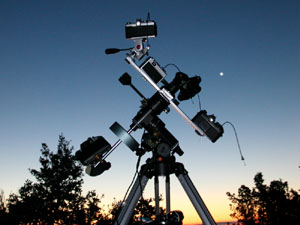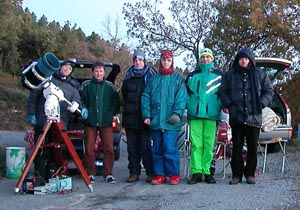
The Lion roars again!
by Lorenzo Comolli

 |
The Lion roars again! by Lorenzo Comolli |
 |
Here are presented some of the elaboration
made starting from the acquired exposures.
I've used also a digital video camera with
a double advantage: obtaining a film of the Leonids and a hi-quality audio
track of our comments with a precise indication of the hour.
Panasonic DS-15 digital camcorder, zoom
set at 1x, gain-up (1/10s exposure).
 |
Composition of three meteors (of which
a bolide) fallen in the bright sky of dawn, near the planet Venus, visible
below the cork oak.
|
 |
Graph of ZHR, Zenithal Hourly Rate:
it's referred to a single observer that observe in ideal conditions, with
a limiting magniture of 6.5 and the radiant at zenith.
|
THE OBSERVING SITE
Simply a wonderful night! Five of us have
risked and we went in Southern France (Alberto Gianni, Alessandro Gambaro,
Angelo Veronesi, Marco Marzetta and I). We have trusted in the forecasts
of NOAA AVN model that once more has revealed determining. We have chosen
a place isolated from big city and in height, in the extreme south zone
of the Cote d'Azur, near St Tropez and Toulon. The place is in the Massif
des Maures, a big and splendid forest hilly/mountainous of cork oaks. We
went on the top of Notre Dame des Anges and we stopped little under the
peak at 700m height. (43°16'45"N, 6°17'51"E, data from the
GPS of Alessandro).
 |
The last forecasts of NOAA
that we consulted a little before departure for France: the best continental
location was Southern France. The left image is a forecast for 0 UT of
november 19, the right one is for 6 UT, near the predicted peak of 4 UT.
Forecasts made on observations of november 18, 6 UT.
|
 |
Chart of some of the succesful expeditions
made by GAT astronomical club members: three in Southern France and one
in Sicily.
|
 |
Detail of the observing site, in a
curve of the road that go to the top of mount Notre Dame des Anges, at
700m height.
|
THE OBSERVATIONS
Leonids does not
disappoint us, giving a wonderful show, a little less than 1999 shower
(but now there was also a Full Moon in the sky that prevented to observe
the faintest Leonids).
The peak seemed
a little in dalay, maybe at 4.08 UT. We observed a lot of bright meteors
(mag -2/-3) with trail in the ascending phase of the peak, while in the
descending phase the medium magnitude seemed inferior.
The total number of Leonids observed is evalutated in about a thousand. Data of the night: limiting magnitude about +5 (before the peak) and +5,5 (during and after the peak), a very transparent sky, no clouds all over the night, temperature between +4 and +6°C, RH at 100% but after 4 UT it descended at 70%.
The first elaborations
ob observing datas show a peak at about 4.08 UT with an HT of 1049, that
considering r=2 and limmag=5.5 give a ZHR of 2474. A secondary peak overlapped
to the descending phase was observed at about 2.24 UT with HR=628 and ZHR=1436.
 |
The observing location on a curve of
the road that go to the top of mount Notre Dame des Anges, on which there
is a repeating tower, visible in the image. In the center Alessandro and
his telescope.
|
FIREBALLS
Three were the wonderful fireballs of
Moon brightness: the first at 4.37.21 UT (hour extracted from audio and
video tapes) esteemed of about mag -12, with double ending explosion, toward
South at about 15° height, green coloured (but also a little red),
with a trail visible for abour 5-10 minutes that was observed evolving
in shape of a spiral galaxy in some tens of seconds.
The second fireball was at 5.02.19 UT, unfortunately we didn't observed directly, we saw the big flash on the road, we esteemed of about mag -15, more that Full Moon. Bursted near Sirius, it left a trail visible for more than 10 minutes.
Then the last at 5.11.30 UT, maybe the brightest, not observed by nobody because falled near the Moon at West, behind a tree that shielded us from the lunar light. We observed a double flash in the trees, of a very saturated red colour. The brightness would be at least equal or more than the previous fireball, judjing only from flash.
Many other was the observed bolides, that
in "normal" conditions would be considered exceptionals, with magnitudes
between -6 and -10.
Find in the end of this page some images
of the photographed fireballs.
THE PHOTOS
The photographic works were one of the
principal objectives of the expedition, four of us made images and two
of us using motorized equatorial mounts. My instruments were composed of
five 35mm cameras, with three 50mm f/1,8, a 40mm f/2,8 and a 16mm f/2,8,
all mounted on the small Kenko NES mount. The two first fireballs were
recorded on 16mm frames.
I've also used a digital camcorder for
recording tens of meteors, toward the radiant.
The observing location was so bewildered
that in all the night no car passed (we occupied completely a curve...)
except that of a french amatour astronomer (Cyrille) that then stopped
with us for observing and recording meteors with a modified webcam and
a camera. He captured the first fireball.
 |
The instruments used for imaging the
Leonids: 5 cameras on the Kenko NES mount. four on the base plate and one
on the counterweight bar. Venus is visible at right of the cameras.
|
 |
Venus in the dawn sky.
|
 |
A group picture of the observers: from
left Alessandro, Cyrille, Alberto, Lorenzo, Angelo, Marco.
|
CONCLUSION
I think that the many km of the trip (500+500km)
were broadly repaied! Also the other members of the expedition absolutely
agree.
After the observing night we found a hotel
for sleeping before the return.

For every comment about images, or about my bad english: comolli@libero.it
|
|